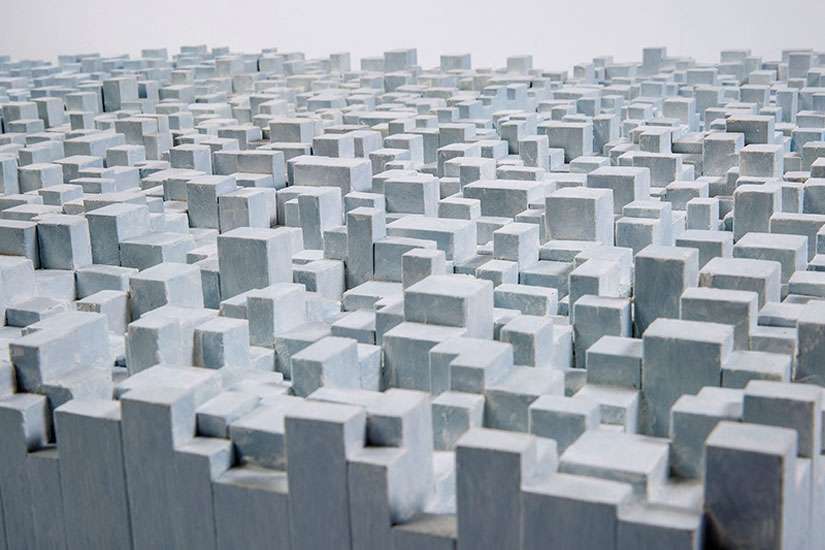When she learned the plate belonged to the man’s sister, who was murdered in the Holocaust, the curator gave him a life membership to the museum because the ritual object, which had been a wedding gift, was the closest the mourner could get to his sister’s remains.
That man, Herbert Kahn, was the father of Tobi Kahn, one of the 13 artists whose work will be on display at the National September 11 Memorial Museum for the next 16 months in an exhibit called, “Rendering the Unthinkable: Artists Respond to 9/11.”
All of the works were created out of a need to respond to the event; none were commissioned specifically by the museum, according to its press release. The media that the artists work in ranges from painting and works on paper to sculpture and video, including a 2003 video by the performance art company the Blue Man Group.
The piece by Kahn, titled “M’AHL,” is a sculpture meant to be viewed from above. Measuring 80 by 42 inches, it is a floor relief made up of thousands of blocks of wood remnants that evoke the view of the city skyline from the top of the World Trade Center.
In an interview with RNS, Kahn recalled as a child going with his parents and grandparents to the restaurant at the top of the North Tower, Windows on the World, and looking out at the “city beckoning from below.”
“Like a Lego set, so beautiful,” he said. After the attacks, with the site covered in ash, the whole area became “like a ghost town.”
The work was created from “remaindered” blocks of wood in Kahn’s studio that had been used for other projects. It is divided into 12 sections that are covered with layers of paint, first “bluish like the buildings, then white like the ash over it,” Kahn said.
The sections have different owners who agreed when they bought them to loan them out to be exhibited together in museums.
The religious significance of the site and his piece is clear to the artist as a child of Holocaust survivors.
In his artist’s statement, he writes that he hopes his work will be a redemptive force that helps to heal.
“Grief ruptures meaning,” he says. “Art can be a small, still voice that begins to mend it — not by trying to represent those who are missing or by attempting to portray their absence, but by inviting all of us who live after them to our own imaginative encounter with the possibilities of memory.”
The director of the museum, Alice Greenwald, formerly an associate director at the United States Holocaust Memorial Museum in Washington, believes the art in these institutions should honor the memory of the victims and should take into account the feelings of family members of victims, survivors and first responders.
“How do you frame a narrative of horrific history in a way sensitive to needs and sensibilities of people impacted by the event?” she asked.
“Obviously as a Jew, I inherited a tradition of storytelling.
“When you read a Haggadah at Passover you are remembering a history that tells you who you are as a person,” she added. “If you remember your experience you can be empathetic to the experiences of others.”
Greenwald said she feels the art exhibit at the 9/11 museum is “very spiritual” even if she does not know whether all the artists would define it that way.
However, not all in the museum world agree that art has a place in commemoration.
“Killing people is too important a subject to be left to museums,” said Tom Freudenheim, the retired founding director of the Jewish Museum in Berlin.
He said an artistic memorial won’t stop mass murderers from killing, or reduce the number of neo-Nazis in the world.
But Kahn believes there is a need to not only tell the story of an event but use religious and artistic means to grapple with catastrophe and find meaning in the aftermath.
“When someone dies, I believe the ‘neshama’ (soul) is there. There is something that is left,” he said. “I want my work to take you to a higher place. … That’s what I am hoping — good art does that.”


